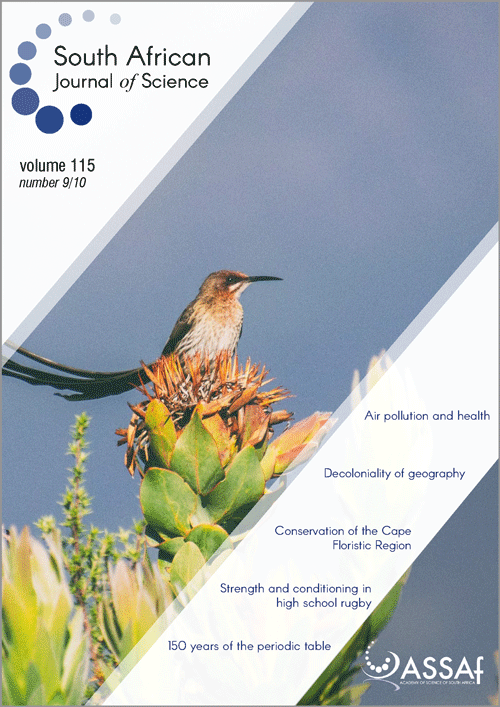Spatial variability of PM10, PM2.5 and PM chemical components in an industrialised rural area within a mountainous terrain
DOI:
https://doi.org/10.17159/sajs.2019/6174Keywords:
complex terrain, passive samplers, mixing height, air pollution potentialAbstract
We describe the measurement and spatial variability of particulate matter (PM) chemical composition, PM10 and PM2.5 in the Greater Tubatse Municipality, South Africa. Monthly samples were collected over 12 months (July 2015 to June 2016) using the inexpensive and easy to operate passive samplers of the University of North Carolina. Sites for sample collection were located at private residences, a church, a hospital and a school. Concentrations of PM10, PM2.5 and PM chemical components were determined using computer-controlled scanning electron microscopy with energy-dispersive X-ray spectroscopy. The annual observed concentrations at all sites were below the South African National Ambient Air Quality Standards of 40 μg/m3 for PM10 and 25 μg/m3 for PM2.5. The Cr-rich and CrFe-rich particles showed substantial heterogeneity with high concentrations observed near the chrome smelters, and Si-rich particles were highest near the silicon mine. SiAl-rich particles were highest at sites close to busy roads, while SiAlFe-rich particles were less spatially distributed. The low spatial variability of SiAlFe-rich particles indicates that these elements are mainly found in crustal material. Using the synoptic meteorological parameters of The Air Pollution Model, we were unable to effectively determine correlations between PM10 and mixing height, Monin–Obukhov length, air pollution potential, or coefficient of divergence.
Significance:
- We have shown that the use of University of North Carolina passive samplers coupled with computer-controlled scanning electron microscopy is effective in determining the chemical composition of PM.
- The use of passive samplers is a cheap and effective method to collect data in remote areas of South Africa which have limited or no electricity supply.
- Assessment of the spatial distribution of PM and PM chemical components can assist in the development of effective air quality management strategies.
Published
Issue
Section
License

All articles are published under a Creative Commons Attribution 4.0 International Licence
Copyright is retained by the authors. Readers are welcome to reproduce, share and adapt the content without permission provided the source is attributed.
Disclaimer: The publisher and editors accept no responsibility for statements made by the authors
How to Cite
- Abstract 1372
- PDF 749
- EPUB 235
- XML 446












.png)